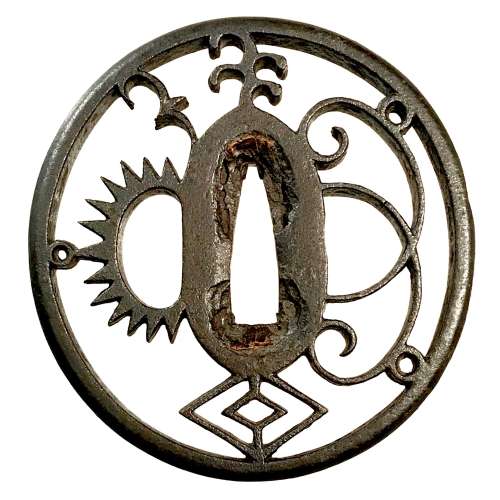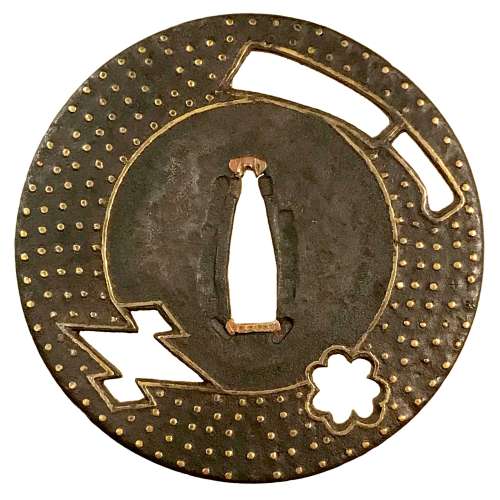-
 Iron tsuba of a round form (maru-gata) pierced (sukashi) with two six-petal flowers at 6 and 12 o’clock and modified lozenges at 3 and 9 o’clock, and inlaid in brass (suemon-zōgan) with tendrils and flowers (chrysanthemum, cherry blossom, Chinese bellflower, paulownia); openings outlined with scalloped brass wire. The plate is slightly concave with traces of lacquer on the surface. Nakago-ana plugged with copper sekigane. Some elements of inlay missing. The rim with conspicuous tekkotsu, quite worn. Measurements: Height 92.0 mm; Width 86.3 mm; thickness at seppa-dai 3.2 mm, at rim 4.2 mm. Time: Late Muromachi (1514 – 1573) or earlier.
Iron tsuba of a round form (maru-gata) pierced (sukashi) with two six-petal flowers at 6 and 12 o’clock and modified lozenges at 3 and 9 o’clock, and inlaid in brass (suemon-zōgan) with tendrils and flowers (chrysanthemum, cherry blossom, Chinese bellflower, paulownia); openings outlined with scalloped brass wire. The plate is slightly concave with traces of lacquer on the surface. Nakago-ana plugged with copper sekigane. Some elements of inlay missing. The rim with conspicuous tekkotsu, quite worn. Measurements: Height 92.0 mm; Width 86.3 mm; thickness at seppa-dai 3.2 mm, at rim 4.2 mm. Time: Late Muromachi (1514 – 1573) or earlier. -
 Iron tsuba of round form with a dense combination of symbols: slanting rays of light (shakoh) Christian motif (Jesuit's IHS symbol), also often described as "tokei" or "clock gear", wild goose in flight, bracken, and lozenges in openwork (sukashi). Copper sekigane. Edo period.
Iron tsuba of round form with a dense combination of symbols: slanting rays of light (shakoh) Christian motif (Jesuit's IHS symbol), also often described as "tokei" or "clock gear", wild goose in flight, bracken, and lozenges in openwork (sukashi). Copper sekigane. Edo period.Size: 76.0 x 72.6 x 6.2 mm
Unsigned.
For information regarding shakoh tsuba see article 'Kirishitan Ikenie Tsuba by Fred Geyer at Kokusai Tosogu Kai; The 2nd International Convention & Exhibition, October 18-23, 2006, pp. 84-91.
-
 Onin Tsuba with two overlapping lozenges, or interlocked diamond shapes. Iron and brass. Sukashi and ten-zogan technique. Muromachi period. Diameter: 81.0 mm; Thickness at seppa-dai: 3.2 mm The symbol of two overlapping lozenges (or, interlocked diamond shapes), presumably a family crest (kamon) may be deciphered as chigai kuginuki (nail extraction tool => 'conquered nine castles' ) or as chigai bishi (overlapping lozenges). Similar symbol can be found at Butterfield & Butterfield. IMPORTANT JAPANESE SWORDS, SWORD FITTINGS AND ARMOR. Auction Monday, November 19th, 1979. Sale # 3063], №94 with the following explanation: " This was the mon (crest) of the Yonekura family of Kaga Prov., at Kanazawa". An interesting insight is provided by Robert E. Haynes at Important Japanese kodogu, gaiso and works of art. San Francisco, April 9-11, 1982. Robert E. Haynes, Ltd., № 36 (see photo): "This would seem to be the Yonekura family mon. They were Seiwa-Genji Daimyō family made noble in 1696 and resided in Kanazawa in Kaga". Would it be possible that this is a late 17th century Ōnin tsuba?
Onin Tsuba with two overlapping lozenges, or interlocked diamond shapes. Iron and brass. Sukashi and ten-zogan technique. Muromachi period. Diameter: 81.0 mm; Thickness at seppa-dai: 3.2 mm The symbol of two overlapping lozenges (or, interlocked diamond shapes), presumably a family crest (kamon) may be deciphered as chigai kuginuki (nail extraction tool => 'conquered nine castles' ) or as chigai bishi (overlapping lozenges). Similar symbol can be found at Butterfield & Butterfield. IMPORTANT JAPANESE SWORDS, SWORD FITTINGS AND ARMOR. Auction Monday, November 19th, 1979. Sale # 3063], №94 with the following explanation: " This was the mon (crest) of the Yonekura family of Kaga Prov., at Kanazawa". An interesting insight is provided by Robert E. Haynes at Important Japanese kodogu, gaiso and works of art. San Francisco, April 9-11, 1982. Robert E. Haynes, Ltd., № 36 (see photo): "This would seem to be the Yonekura family mon. They were Seiwa-Genji Daimyō family made noble in 1696 and resided in Kanazawa in Kaga". Would it be possible that this is a late 17th century Ōnin tsuba?
Robert E. Haynes Catalog of April 9-11, 1982, № 36.
-

Iron tsuba of round form with design of hatchet, snowflake, and triple diamond in openwork (ko-sukashi), and inlaid with five concentric circles of brass dots (ten-zōgan) and brass inner circular line. Sukashi elements outlined in brass.
Late Muromachi period. Diameter: 82.4 mm; Thickness: 3.0 mm The triple lozenge (or diamond) is similar to the one on TSU-305 from Sasano Collection # 15. Very old motif; as Sasano remarks in his book "...represents the unstable political situation at the time".Kokusai Tosogu Kai 5th International Convention & Exhibition, October 28-30, 2009 at NEZU Museum, Tokyo, Japan, on page 83 provides the following explanation of the triple diamond symbol: "The pine bark is the form of the Diamonds, "Bishi", mon, seen from Nara period, found on cloth stored in the Shoso In, and used primarily by the Takeda family. The form of Bishi mon [similar to ours] is called "Chu Kage Matsukawa Bishi", (Middle Shaded Pine Bark Diamond)."
A combination of hatchet (usually an axe) and a triple diamond (Matsukawabishi) alludes to the Nō play Hachi-no-ki (ref: Iron tsuba. The works of the exhibition "Kurogane no hana", The Japanese Sword Museum, 2014; AND Sasano: Japanese Sword Guard Masterpieces from the Sasano Collection. By Sasano Masayuki. Part One. Published in Japan in 1994.


